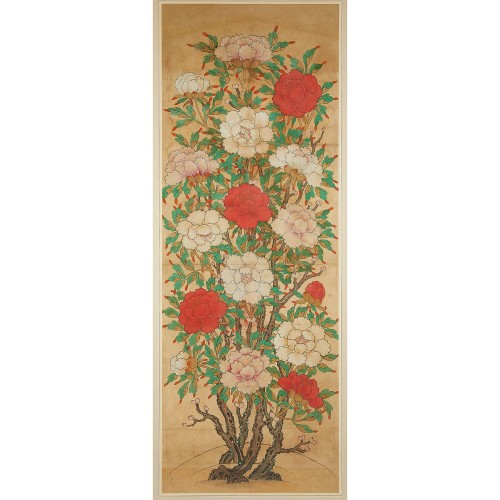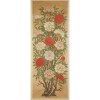본문
이 모란도(牡丹圖)는 조선시대 궁중의 당채색화(唐彩色畵)로 부귀와 영화, 장수를 상징하는 도상을 화려하게 표현한 유물입니다. 두껍고 진한 안료를 겹쳐 바르는 기법을 통해 깊이감 있는 색조와 궁중 회화 특유의 품격을 보여줍니다.
화면 전체를 가득 메운 모란 나무에는 정면과 측면에서 피어난 만개한 꽃과 봉오리가 조화롭게 배치되어 있습니다. 백색, 홍색, 담홍색 등 다양한 색조의 꽃들이 반복되어 리듬감을 줍니다. 가지는 굵고 역동적으로 휘어지며, 엽맥(葉脈)이 선명한 잎들과 함께 모란의 생명력을 강조합니다.
이처럼 수직으로 뻗은 구도와 반복적인 도상은 조선 궁중회화의 특징을 잘 보여주며, 모란 나무가 병풍 전체를 연결하는 형식으로 구성되었습니다.
모란은 ‘화중왕(花中王)’이라 불리며 왕실의 위엄과 권위를 상징하는 꽃입니다. 화면을 가득 메운 형상과 함께 대형 구성으로 압도적인 존재감을 드러냅니다. 이처럼 대작으로 제작된 모란도는 많은 재료와 인력이 투입되어야 했기에 민간에서는 보기 어려운 유형으로, 궁중 회화의 전형적 양식을 보여주는 유물입니다.
━━━━━
这幅《牡丹图》是朝鲜时代宫廷所绘的唐彩画,借助象征富贵、荣华与长寿的图案,展现出华丽庄严的艺术风格。画面采用层层叠加浓厚颜料的技法,色彩浓郁富有层次,体现出宫廷绘画特有的格调与深度。
画面中,一整株盛开的牡丹树贯穿整体构图,花朵从正面与侧面交错绽放,盛放的花朵与含苞的花蕾相互呼应,布局和谐。白、红、粉等多种色调的牡丹反复出现,营造出视觉的韵律感。枝干粗壮有力,曲折延展,与脉络清晰的叶片共同突出牡丹的旺盛生命力。
如此垂直延展的构图方式与反复呈现的图像元素,是朝鲜宫廷绘画的典型特色。牡丹树的形象贯穿整个画屏,形成一体化的连续画面。
牡丹素有“花中之王”之称,是王权与尊贵的象征。整幅画面以巨幅形式展开,充满视觉张力与压倒性的气势。如此规模的作品制作需大量颜料与人力,故民间极为罕见,是体现宫廷绘画典范样式的重要文物。
━━━━━
This Palace Peony Painting, a royal Tang-style polychrome painting from the Joseon Dynasty, is a richly expressive work symbolizing wealth, glory, and longevity. Layered applications of thick, intense pigments create a rich sense of depth and exemplify the elegance of court painting.
The entire surface is filled with a large peony tree, with blossoms and buds depicted from both frontal and side views, arranged harmoniously. Flowers in white, red, and pale pink are repeated to create a rhythmic visual flow. The branches curve boldly and dynamically, while the leaves, with their pronounced veins, emphasize the vitality of the peony.
The vertical composition and repetitive motifs exemplify key features of Joseon court painting. The peony tree structure connects the panels across the entire screen format.
Revered as the “King of Flowers”, the peony symbolizes royal dignity and authority. Its large-scale composition, filling the entire frame, conveys a commanding presence. Such grand peony screens required extensive materials and labor and were rarely found in private homes, making this a prime example of traditional court painting.

